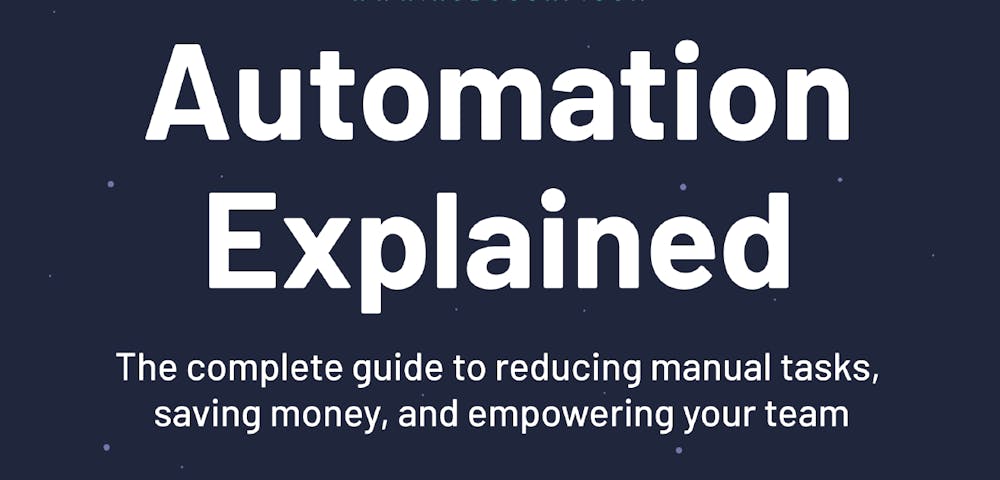
What is RPA? A breakdown of RPA and its benefits
Robocorp's guide to automation. Explore the benefits, its use cases, and how an RPA platform can transform your business.
September 23, 2021 – Robocorp
As we have (proudly) stated before, Robocorp built an open-source RPA platform that allows our partners and customers to use robots to automate repetitive mundane tasks. But what exactly is RPA? And what are these robots, and just what do they do? We’ve got answers to your questions, so consider today your lucky day.
What is RPA Software?
You may already know, but for those in the back, RPA stands for robotic process automation. It is a type of business process automation that involves software robots automating manual, multi-step tasks that typically take businesses a lot of time, labor, and capital to complete.
RPA robots are what you might imagine. They are not physical machines, and they don’t sit at desks pushing paper. Software robots—”bots” for short—are made up of lines of code, and they live in the cloud, which means they can be easily edited, updated, and improved upon. Anytime, anywhere.
Tasks that are particularly well-suited for automation include:
- Interaction between APIs
- Analyzing and processing data
- Scraping information from the web
- Moving data between applications
There are a whole lot more, but you get the idea. Any repetitive, high-volume task that you want streamlined or managed in less time, with fewer mistakes - a software robot can complete.
Learn more in our Automation Explained eBook. Click here to download for free.

What do RPA bots do?
Simply put, bots handle the tasks that your employees currently undertake, with one key difference: the bots work faster and more efficiently than a human ever could. Because they can complete multiple functions at the same time, coordinating between web and desktop applications, accessing mainframe terminals, and inputting information into databases (to name just a few functions), they are incredibly systematic and methodical.
Software robots rarely make mistakes, and over time they effectively drop your opportunity for error down to almost zero. Like we touched on earlier - they can cover a wide variety of business function, but here’s a brief overview of areas where they really shine:
- Copying and pasting data between applications
- Logging into applications with no API, APIs, or a mix of both
- Reading and writing databases
- Making calculations and running through routine workflows
- Scraping data from the web
- Analyzing, processing, and extracting content from documents and emails - including tricky PDFs
- Interacting with collaboration tools like email and messaging platforms
- Leveraging advanced analytics and machine learning to make intelligent decisions
What are the benefits of RPA?
Automation offers a series of advantages, especially when it comes to gaining an edge over competitors. By automating the repetitive tasks, you are able to:
Free up resources
All those mundane tasks that humans hate doing, a software robot can complete in half the time. As such, businesses find they are able to move labor away from house-keeping, and direct this energy toward revenue-generating activities instead.
Reduce costs
Software robots can cost 50% less to develop and deploy than salaried employees, and that’s just for the first year. The longer you use them, the cheaper they get, yielding excellent ROI as time goes on.
Achieve sustainable scalability
Those tasks you decide to automate? You can scale them, too. Which means as you accrue more clients, you don’t have to worry about expending time and energy on more hires, worker onboarding, and months-long training periods: just add it to your robot’s to-do list.
Connecting your platforms and systems
Software robots have the ability to automate within most existing tech environments that your business already relies on. Here’s a quick rundown of the platforms that Robocorp’s bots can work within, thanks to our Python-based stack and use of open APIs:
- Browser automation. Open a browser, navigate, log in, and perform actions.
- Desktop applications. Automate applications within Windows, Linux, and macOS environments.
- API and HTTP automations. Transfer data between applications using their APIs and through HTTP requests.
- Cloud Services. Automatically process data, documents, and images, and include AI/ML when needed.
The following are common platforms used in desktop automation:
- SAP - Control SAP GUI desktop client to automate SAP workflows.
- Netsuite - Netsuite can be automated by accessing the Netsuite SuiteTalk Service
- Mainframe - Automation libraries are used to interact with mainframe systems.
- Citrix - Image automation is used to control Citrix-based virtual applications
- Microsoft Office - including the often-automated Excel
What is RPA used for?
Now we’ve got a handle on what software robots are capable of - let’s put words into action. Automation has a place in nearly every department in businesses in all industries. You can learn more on our solutions page, but here are some popular uses of RPA:
- Master data management. Automate data backups and restorations.
- Human resources. Expedite and automate employee onboarding and offboarding, while simultaneously decreasing human error and increasing employee satisfaction levels, just like Teknei accomplished.
- Finance and accounting. Save time and labor by getting robots to handle accounts payable, invoice processing, closings, and more - just like Thoughtful Automation did.
- Customer communication. Get robots to create shipping labels, update ticketing systems, and migrate client data, just like NyxTech did
- Processing multiple insurance policies. Increase productivity and employee satisfaction by automating mundane tasks of manually processing thousands of insurance policies while saving costs & time, just like Quandri provided for their customer.
There are many more uses of RPA. We encourage you to consider what tedious and repetitive tasks that your team currently performs, and reach out to a member of the Robocorp team or to one of our certified partners to explore the possibility of automating it. And on that note...
How to get started with RPA
As you’ve probably gauged by now - automation can be immensely helpful for many businesses. But how can it best serve yours?
To understand the role RPA could play in your business model—and importantly the ROI, increased profits, and capital savings it could generate—it’s important to first gauge the following:
- Write down all the highest-volume, repeat tasks that are both time and labor-intensive
undefined - List out all other non-revenue generating tasks that you’d consider general house-keeping.
- Speak with your team: what are the most mundane tasks? What hurdles do they frequently run into? What other duties would they instead like to dedicate their time to?
- List out all your most used applications and platforms: Salesforce, HubSpot, AWS, and so on. Keep these on hand to discuss with potential RPA providers and ensure their bots can implement with your toolkit.
We invite you to reach out to us at any point during your internal brainstorming and planning. You can contact us directly to schedule a time to discuss what Robocorp’s software could do for your business. We also encourage you to get to know our partners and give them a call.
Robocorp’s global network of partners have experience with businesses of all sizes and across industries, so there’s a good chance you’ll find a fit for you. Click here to visit our directory of certified partners.